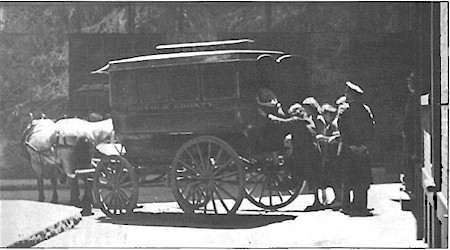Prisoner Custody in the 1880's
U. S. Marshals, similar to today, relied upon local sheriffs for jail space in the early to mid-1880's. The marshals also rented the places in which court was held and prisoners were housed. Generally during this period, the federal government did not build or maintain its own courthouses, preferring to lease county courtrooms or other facilities annually. The government refused to rent office space for the marshals and U.S. attorneys, though it did agree to pay for space for clerks to keep court records.

Each marshal and attorney was expected to arrange and pay for his own office. In addition, the marshals and attorneys cleaned their own rooms; payments to janitors were not allowed. Jail space was rented by the week from the local sheriff. Occasionally the local jails caused the marshals problems. In October 1821, Marshal Morton Waring of South Carolina reported the escape of two federal prisoners from the county jail.
"The Marshal, "he complained to the secretary of state, "has no control over the Officers of the Goal, and altho' he may notice the most glaring improprieties, and remonstrate against them, he can do no act which will remedy the evil." The county jail used by the marshals in New York City, according to Marshals Abraham T. Hillyer in 1853, was "utterly insecure." He suggested using the prison in Brooklyn to house his prisoners, despite the expense of transporting them back and forth to court.
By the early 1850's, Attorney General Caleb Cushing considered the lack of adequate courthouses and prisons "a serious evil demanding the attention of the Government." He pointed out to President Franklin Pierce that "in most cases. the courts of the United States are held in buildings belonging to individuals or to the counties, cities or parishes of the respective states upon whom the United States are thus made to depend for their necessary accommodation. This dependence, in the matter of prisoners, is particularly inconvenient." On several occasions, when northern marshals tried to house fugitive slaves in local jails before extraditing them to the South, the states had refused to allow the marshals to use their prisons. Cushing believed that the time had come for the United States to build its own courthouses and prisons.
Such an application of some part of the public treasure will be perfectly constitutional and proper and the object is one of unquestionable public exigency and utility.
However, construction of the facilities did not begin in earnest until after the Civil War. Fortunately, the marshals during this period were not overwhelmed with prisoners.
On February 23, 1846, Secretary of the Treasury R.J. Walker polled the marshals on the number of federal prisoners housed in state prisons in their districts, the cost per day, and the names and crimes of the felons. Sixteen marshals responded to the survey, four of whom reported that they had no prisoners.
Marshal Thomas Fletcher of Mississippi informed the Treasury that in fifteen years his court had never had an indictment or a conviction. The court in western Tennessee, according to Marshal Robert I. Chester, had never sentenced a defendant to prison. In Virginia no prisoner had been sentenced for a dozen years, since the spring 1834 court term. Marshal Samuel Hays of western Pennsylvania had had no prisoners during his first year as marshal. Four districts reported only one prisoner; three districts reported two prisoners. Five of the prisoners were mail robbers, two were counterfeiters, two had been convicted of manslaughter on the high seas, and one had engaged in the African slave trade. The remaining five districts reported slightly higher numbers of prisoners-four, five, six, eight, and eleven felons. Northern New York had the most prisoners, followed by its neighbor southern New York. The crimes were mail robbery or embezzlement; murder, assault, or piracy on the high seas; engaging in the African slave trade; counterfeiting and forgery; perjury; stealing federal property; and attempting to create a revolt.

